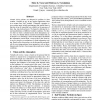Free Online Productivity Tools
i2Speak
i2Symbol
i2OCR
iTex2Img
iWeb2Print
iWeb2Shot
i2Type
iPdf2Split
iPdf2Merge
i2Bopomofo
i2Arabic
i2Style
i2Image
i2PDF
iLatex2Rtf
Sci2ools
ICCV
1999
IEEE
1999
IEEE
Vision in Bad Weather
Current vision systems are designed to perform in clear weather. Needless to say, in any outdoor application, there is no escape from "bad" weather. Ultimately, computer vision systems must include mechanisms that enable them to function (even if somewhat less reliably) in the presence of haze, fog, rain, hail and snow. We begin by studying the visual manifestations of different weather conditions. For this, we draw on what is already known about atmospheric optics. Next, we identify effects caused by bad weather that can be turned to our advantage. Since the atmosphere modulates the information carried from a scene point to the observer, it can be viewed as a mechanism of visual information coding. Based on this observation, we develop models and methods for recovering pertinent scene properties, such as threedimensional structure, from images taken under poor weather conditions. 1 Vision and the Atmosphere Virtually all work in vision is based on the premise that the obser...
Atmospheric Optics | Clear Weather | Computer Vision | Current Vision Systems | ICCV 1999 | Pertinent Scene Properties | Weather Conditions |
Related Content
| Added | 15 Oct 2009 |
| Updated | 15 Oct 2009 |
| Type | Conference |
| Year | 1999 |
| Where | ICCV |
| Authors | Shree K. Nayar, Srinivasa G. Narasimhan |
Comments (0)

